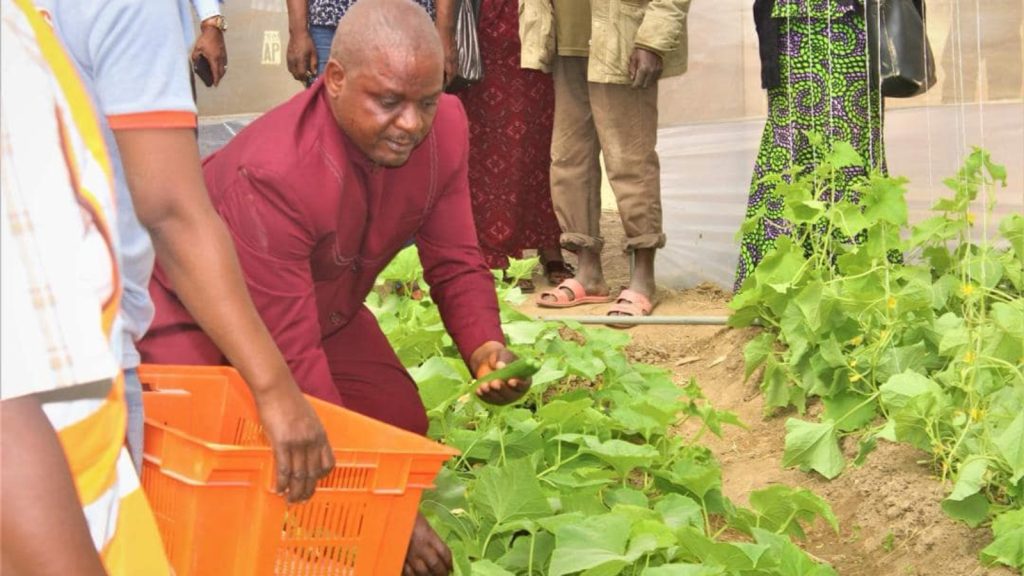ACReSAL Benue
The ACReSAL project is a multi-sectoral and multi-institutional scheme covering Environment, Agriculture, and Water. The Federal Government designed it to combat desertification and restore degraded lands and unique ecosystems for agriculture and biodiversity conservation.
ACReSAL will improve land use planning, restore degraded land and increase food productivity.

Climate and Vegetation
Based on Koppen’s Scheme of Classification, Benue State lies within the AW Climate (Tropical Savannah Climate) and experiences two distinct seasons, the wet/rainy season and the dry/summer season. The rainy season lasts from April to October with annual rainfall in the range of 100-200mm. The dry season begins in November and ends in March. Temperatures fluctuate between 23 – 37 degrees Celsius during the year. The south-eastern part of the state adjoining the Obudu-Cameroun Mountain range, however, has a cooler climate similar to that of the Jos Plateau.
The vegetation of the State consists of rain forests which have tall trees, tall grasses and oil palm trees that occupy the state’s western and southern fringes while the Guinea savannah is found in the eastern and northern parts with mixed grasses and trees that are generally of average height. Benue’s topography is mainly undulating plains with occasional elevations of between 1,500m and 3,000m above sea level. The state’s main geological formations are sandy-loam shelf basement complex and alluvial plains. These together with its location in the transition belt between the north and south ecologies and a favourable rainfall pattern account for its support for a wide variety of crops.
SPECIFIC ENVIRONMENTAL CHALLENGES IN BENUE STATE
Benue State is within the Southern Guinea Savanna agro-ecological zone of Nigeria, which is characterized by distinct wet and dry season. The landform is moderately undulating. In the face of global warming, the effects are extreme as people of the State are principally engaged in agricultural activities. This activities account for a greater percentage of the degradation types which may be summed up to include:
(a)Deforestation/Desertification:
Naturally, most parts of Benue State belong to a derived Savanna region. The constant felling of trees has generated lush regeneration of grasses over time. However, the encroachment on marginal lands due to loss of fertile and productive lands occasioned by the quest to increase productivity, and due to demand for fuel wood and timber, certain parts of Benue State are excessively deforested and are prone to desertification and its attendant effect.
(b)Flood and Drought:
There have been issues of droughts in Makurdi in years like 1988, 1993 and 2005, some say the drought years are increasing other argue that the wet days are increasing evident in the recent flood events of 2000, 2008 and 2012, some of these recent flooding have rendered residents of Makurdi homeless and properties including farm lands worth millions of naira destroyed, and people living around the river banks displaced.
(c)Erosion:
Due to the clearing away of the surface cover/vegetation in order to produce food and cash crops, some surface areas are usually left bare and the rate of surface run-off increases leading to wearing away of land surface which leads to reduction in fertility of the soils. This is not healthy for crops and plantation since the top soils are the richer in soil nutrients and organic matter content. This could be noticed more in the resultant gullies at the southern parts of Benue State e.g. Otukpo, Otukpa and Ugbokolo. Siltation and accumulation of silt particles in streams and rivers in most part of Benue State are also common as a result of water erosion.
(d)Organic matter depletion: Constant bush burning activities coupled with rapid mineralization of organic matter is a common feature of low income agriculture especially in the tropics. This leads to rapid organic matter depletion. Organic matter is the storehouse of nutrients and a soil modification material. Its depletion causes impoverishment of soil nutrient status and consequently increases the vulnerability of the soil to crumbling and detachment and transport. It is evident that most croplands in the state are unproductive today due to this phenomenon.
(e)Compaction / Crusting: Benue valley consist of Alfisols, Entisols, and Ultisols and these soils are Shallow with underlying clay accumulations and poor internal drainage. These soils also may contain plinthite sub-surface layers and sometimes protrude to surfaces of soils as out-crops. Because of poor internal drainage of these major soils, infiltration is reduced and in periods of high temperature and evapo-transpiration, soil crusting can become an easy feature on some croplands in Benue State. Compaction on the other hand could be due to the overgrazing and overstocking.
CLEARED INTERVENTION SITES
Engagement of consultant for the design of Agro-Forestry Models in 6 LGAs (Oju, Otukpo, Makurdi, Vandeikya, Gboko and Gwer West) is at advance state.










